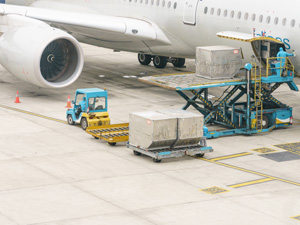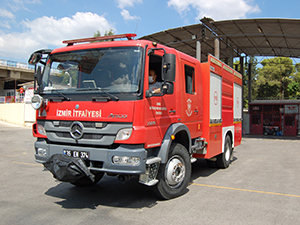June Air Cargo: Stable and Resilient
The International Air Transport Association (IATA) released data for global air cargo markets showing healthy and stable performance.

03 Ağustos 2022 Çarşamba 16:28
Note: We returned to year-on-year traffic comparisons, instead of comparisons with the 2019 period, unless otherwise noted.
- Global demand, measured in cargo tonne-kilometers (CTKs*), was 6.4% below June 2021 levels (-6.6% for international operations). This was an improvement on the year-on-year decline of 8.3% seen in May. Global demand for the first half-year was 4.3% below 2021 levels (-4.2% for international operations). Compared to pre-COVID levels (2019) half-year demand was up 2.2%.
- Capacity was 6.7% above June 2021 (+9.4% for international operations). This was an increase on the 2.7% year-on-year growth recorded in May. Capacity for the first half-year was up 4.5% (+5.7% for international operations) compared to first half-year of 2021. Compared to pre-COVID levels demand was up 2.5%.
- Air cargo performance is being impacted by several factors.
- Trade activity ramped-up slightly in June as lockdowns in China due to Omicron were eased. Emerging regions (Latin America and Africa) also contributed to growth with stronger volumes.
- New export orders, a leading indicator of cargo demand and world trade, decreased in all markets, except China.
- The war in Ukraine continues to impair cargo capacity used to serve Europe as several airlines based in Russia and Ukraine were key cargo players.
“Air cargo demand over the first half of 2022 was 2.2% above pre-COVID levels (first half 2019). That’s a strong performance, particularly considering continuing supply chain constraints and the loss of capacity due to the war in Ukraine. Current economic uncertainties have had little impact on demand for air cargo, but developments will need to be closely monitored in the second half,” said Willie Walsh, IATA’s Director General.
| |||||||||||||||||||||||||||||||||||||||||||||||||
1 % of industry CTKs in 2021 2 Change in load factor 3 Load factor level |
June Regional Performance
- Asia-Pacific airlines saw their air cargo volumes decrease by 2.1% in June 2022 compared to the same month in 2021. This was a significant improvement over the 6.6% decline in May. Demand for the first half-year was 2.7% below 2021 levels. Airlines in the region have been heavily impacted by lower trade and manufacturing activity due to Omicron-related lockdowns in China, however this continued to ease in June as restrictions were lifted. Available capacity in the region fell 6.2% compared to June 2021. This contributed to capacity being 0.2% below 2021 levels for the first half of 2022.
- North American carriers posted a 6.3% decrease in cargo volumes in June 2022 compared to June 2021. Demand for the first half-year was 3.3% below 2021 levels. High inflation is affecting the region. Demand in the Asia-North America market is falling and the Europe – North America market has started to decline. Capacity was up 5.6% in June 2022 compared to June 2021 and up 6.1% for the first half-year of 2022.
- European carriers saw a 13.5% decrease in cargo volumes in June 2022 compared to the same month in 2021. This was the weakest performance of all regions. It was, however, a slight improvement over the previous month’s performance, which saw the sharpest fall in demand since early 2022. This is attributable to the war in Ukraine. Labor shortages and lower manufacturing activity in Asia due to Omicron also affected volumes. Capacity increased 5.6% in June 2022 compared to June 2021. Demand for the first half-year was 7.8% below 2021 levels while capacity was 3.7% above.
- Middle Eastern carriers experienced a 10.8% year-on-year decrease in cargo volumes in June. Significant benefits from traffic being redirected to avoid flying over Russia failed to materialize. Capacity was up 6.7% compared to June 2021. Demand for the first half-year was 9.3% below 2021 levels, the weakest first half performance of all regions. First half-year capacity was 6.3% above 2021 levels.
- Latin American carriers reported an increase of 19.6% in cargo volumes in June 2022 compared to June 2021. This was the strongest performance of all regions. Airlines in this region have shown optimism by introducing new services and capacity, and in some cases investing in additional aircraft for air cargo in the coming months. Capacity in June was up 29.5% compared to the same month in 2021. Demand for the first half-year was 21.8% above 2021 levels and half-year capacity was 32.6% above 2021 levels. This was the strongest first half performance of all regions.
- African airlines saw cargo volumes increase by 5.7% in June 2022 compared to June 2021. As with carriers in Latin America, airlines in this region have shown optimism by introducing additional capacity. Capacity was 10.3% above June 2021 levels. Demand for the first half-year was 2.9% above 2021 levels and half-year capacity was 6.9% above 2021 levels.
Yorumlar
SON DAKİKA
![2025 Atlas Lojistik Ödülleri’ni Kazananlar Ne Dediler? - Melike Batur]() 2025 Atlas Lojistik Ödülleri’ni Kazananlar Ne Dediler? - Melike Batur2025 Atlas Lojistik Ödülleri yarışmasında “En Beğenilen Depo Yöneticisi (Online Oylama)” ödülünü alan Melike Batur’un tören sonrasında kameralarımıza yaptığı açıklamaları ekranlarınıza getiriyoruz.12 Aralık 2025 Cuma 13:15Lojistik
2025 Atlas Lojistik Ödülleri’ni Kazananlar Ne Dediler? - Melike Batur2025 Atlas Lojistik Ödülleri yarışmasında “En Beğenilen Depo Yöneticisi (Online Oylama)” ödülünü alan Melike Batur’un tören sonrasında kameralarımıza yaptığı açıklamaları ekranlarınıza getiriyoruz.12 Aralık 2025 Cuma 13:15Lojistik![Mercedes-Benz Türk Kayseri’de Heska ile Hizmet Ağını Genişletti]() Mercedes-Benz Türk Kayseri’de Heska ile Hizmet Ağını GenişlettiMercedes-Benz Türk, Heska Kayseri bayisini hizmete açarak bölgede satış ve servis ağını güçlendirdi.11 Aralık 2025 Perşembe 16:59Ticari Araçlar
Mercedes-Benz Türk Kayseri’de Heska ile Hizmet Ağını GenişlettiMercedes-Benz Türk, Heska Kayseri bayisini hizmete açarak bölgede satış ve servis ağını güçlendirdi.11 Aralık 2025 Perşembe 16:59Ticari Araçlar![2025 Atlas Lojistik Ödülleri’ni Kazananlar Ne Dediler? - BASF Türk]() 2025 Atlas Lojistik Ödülleri’ni Kazananlar Ne Dediler? - BASF TürkBASF Türkiye ve Orta Doğu, Gümrük ve Dış Ticaret Müdürü Güler Polat’ın Atlas Lojistik Ödülleri töreninde yaptığı açıklamaları ekranlarınıza getiriyoruz.11 Aralık 2025 Perşembe 15:37Ticari Araçlar
2025 Atlas Lojistik Ödülleri’ni Kazananlar Ne Dediler? - BASF TürkBASF Türkiye ve Orta Doğu, Gümrük ve Dış Ticaret Müdürü Güler Polat’ın Atlas Lojistik Ödülleri töreninde yaptığı açıklamaları ekranlarınıza getiriyoruz.11 Aralık 2025 Perşembe 15:37Ticari Araçlar![DP World Evyap Konteyner Elleçlemede 1 Milyon TEU Seviyesine Ulaştı]() DP World Evyap Konteyner Elleçlemede 1 Milyon TEU Seviyesine UlaştıDP World Evyap, 2025’te bir milyon TEU konteyner elleçleme eşiğini aşarak Türkiye’nin lojistik kapasitesindeki dönüşümün öncüsü oldu. İleri teknoloji yatırımlarıyla güçlenen terminal, bölgesel ticarette yeni bir büyüme döneminin kapılarını aralıyor.11 Aralık 2025 Perşembe 10:03Denizcilik
DP World Evyap Konteyner Elleçlemede 1 Milyon TEU Seviyesine UlaştıDP World Evyap, 2025’te bir milyon TEU konteyner elleçleme eşiğini aşarak Türkiye’nin lojistik kapasitesindeki dönüşümün öncüsü oldu. İleri teknoloji yatırımlarıyla güçlenen terminal, bölgesel ticarette yeni bir büyüme döneminin kapılarını aralıyor.11 Aralık 2025 Perşembe 10:03Denizcilik![Shell & Turcas Filoları Geleceğe Taşıyan Çözümlerini logitrans 2025’te Tanıttı]() Shell & Turcas Filoları Geleceğe Taşıyan Çözümlerini logitrans 2025’te Tanıttı“İşi için yolda olan insanların Shell’i” mottosuyla faaliyetlerini sürdüren Shell Filo Çözümleri, lojistik sektörünün en önemli buluşmalarından Uluslararası logitrans Transport Lojistik Fuarı’nda yerini aldı.10 Aralık 2025 Çarşamba 16:44Lojistik
Shell & Turcas Filoları Geleceğe Taşıyan Çözümlerini logitrans 2025’te Tanıttı“İşi için yolda olan insanların Shell’i” mottosuyla faaliyetlerini sürdüren Shell Filo Çözümleri, lojistik sektörünün en önemli buluşmalarından Uluslararası logitrans Transport Lojistik Fuarı’nda yerini aldı.10 Aralık 2025 Çarşamba 16:44Lojistik![Yerli Üretim Peugeot Expert Traveller Yollara Çıkıyor]() Yerli Üretim Peugeot Expert Traveller Yollara ÇıkıyorBursa’daki Tofaş tesisinde üretimi başlayan Expert Traveller, güçlü donanımı ve 2.2 BlueHDi motoruyla Türkiye yollarına çıkmaya hazırlanıyor.10 Aralık 2025 Çarşamba 13:56Ticari Araçlar
Yerli Üretim Peugeot Expert Traveller Yollara ÇıkıyorBursa’daki Tofaş tesisinde üretimi başlayan Expert Traveller, güçlü donanımı ve 2.2 BlueHDi motoruyla Türkiye yollarına çıkmaya hazırlanıyor.10 Aralık 2025 Çarşamba 13:56Ticari Araçlar![Samsun Büyükşehir Acil Sağlık Filosu Volkswagen Crafter ile Güçlendi]() Samsun Büyükşehir Acil Sağlık Filosu Volkswagen Crafter ile GüçlendiSamsun Büyükşehir Belediyesi, 100 ambulans ve 5 hasta nakil aracı olmak üzere toplam 105 adet Volkswagen Crafter aracı filosuna dahil ederek şehrin acil sağlık hizmetlerinde kapasite artışı sağladı.09 Aralık 2025 Salı 16:55Ticari Araçlar
Samsun Büyükşehir Acil Sağlık Filosu Volkswagen Crafter ile GüçlendiSamsun Büyükşehir Belediyesi, 100 ambulans ve 5 hasta nakil aracı olmak üzere toplam 105 adet Volkswagen Crafter aracı filosuna dahil ederek şehrin acil sağlık hizmetlerinde kapasite artışı sağladı.09 Aralık 2025 Salı 16:55Ticari Araçlar![İzmir İtfaiyesi Hızlı Müdahalede Tam Otomatiği Tercih Ediyor]() İzmir İtfaiyesi Hızlı Müdahalede Tam Otomatiği Tercih Ediyorİzmir Büyükşehir Belediyesi İtfaiye Dairesi Başkanlığı araç filosunda bulunan Allison 3000™serisi tam otomatik şanzıman donanımlı kamyonlar, yangın ve acil durum mahallerine hızlı ve güvenilir erişimi destekliyor.09 Aralık 2025 Salı 16:39Ticari Araçlar
İzmir İtfaiyesi Hızlı Müdahalede Tam Otomatiği Tercih Ediyorİzmir Büyükşehir Belediyesi İtfaiye Dairesi Başkanlığı araç filosunda bulunan Allison 3000™serisi tam otomatik şanzıman donanımlı kamyonlar, yangın ve acil durum mahallerine hızlı ve güvenilir erişimi destekliyor.09 Aralık 2025 Salı 16:39Ticari Araçlar![Sürat Lojistik Avrupa Yapılanmasına Hazırlanıyor]() Sürat Lojistik Avrupa Yapılanmasına HazırlanıyorYurt içinde kısa sürede güçlü bir büyüme yakalayan Sürat Lojistik, yurt dışında doğrudan yapılanma hedefiyle Doğu Avrupa’ya odaklanıyor. Şirket, Polonya ve Romanya’yı Avrupa’daki ilk operasyonel adım olarak konumlandırıyor.09 Aralık 2025 Salı 16:05Lojistik
Sürat Lojistik Avrupa Yapılanmasına HazırlanıyorYurt içinde kısa sürede güçlü bir büyüme yakalayan Sürat Lojistik, yurt dışında doğrudan yapılanma hedefiyle Doğu Avrupa’ya odaklanıyor. Şirket, Polonya ve Romanya’yı Avrupa’daki ilk operasyonel adım olarak konumlandırıyor.09 Aralık 2025 Salı 16:05Lojistik![IATA Hava Kargodaki Büyümenin Devam Edeceğini ve 2026’da Gelirlerin 158 Milyar Dolar Olacağını Öngörüyor]() IATA Hava Kargodaki Büyümenin Devam Edeceğini ve 2026’da Gelirlerin 158 Milyar Dolar Olacağını ÖngörüyorUluslararası Hava Taşımacılığı Birliği (IATA), tedarik zinciri sorunları sürerken küresel havayolu endüstrisinin kârlılığının dengelendiğini gösteren en son finansal görünümünü ve 2026 öngörülerini yayımladı.09 Aralık 2025 Salı 14:59Havayolu
IATA Hava Kargodaki Büyümenin Devam Edeceğini ve 2026’da Gelirlerin 158 Milyar Dolar Olacağını ÖngörüyorUluslararası Hava Taşımacılığı Birliği (IATA), tedarik zinciri sorunları sürerken küresel havayolu endüstrisinin kârlılığının dengelendiğini gösteren en son finansal görünümünü ve 2026 öngörülerini yayımladı.09 Aralık 2025 Salı 14:59Havayolu
- Geri
- Ana Sayfa
- Normal Görünüm
- © 2025 Kargo Haber


















Türkçe karakter kullanılmayan ve büyük harflerle yazılmış yorumlar onaylanmamaktadır.